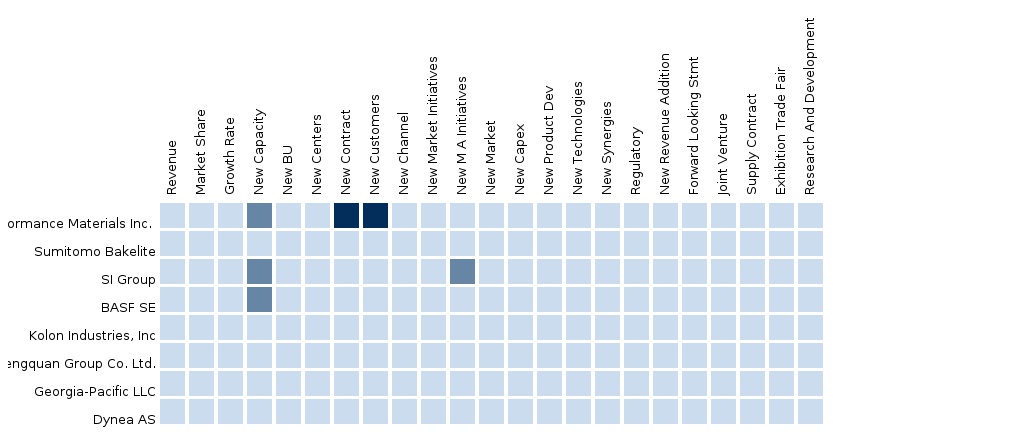1 Introduction
1.1 Objective of the study
1.2 Market Definitions
1.3 Market Segmentation & Aspects Covered
1.4 Research Methodology
1.4.1 Assumptions (Market Size, Forecast, etc)
2 Executive Summary
3 Market Overview
4 Phenolic Resins-Europe, By Applications
4.1 Split By Geography
4.1 Phenolic Resins-France by Applications
4.1 Phenolic Resins-Germany by Applications
4.1 Phenolic Resins-Italy by Applications
4.1 Phenolic Resins-Spain by Applications
4.1 Phenolic Resins-Europe - Russia by Applications
4.1 Phenolic Resins-Europe - Belgium by Applications
4.1 Phenolic Resins-Europe - Poland by Applications
4.1 Phenolic Resins-Europe - Other Geographies by Applications
4.2 Phenolic Resins-Europe-Adhesives & Sealants
4.2.1 Phenolic Resins-Europe-Adhesives & Sealants, By Geographies
4.2.1.1 Phenolic Resins-France-Adhesives & Sealants
4.2.1.2 Phenolic Resins-Germany-Adhesives & Sealants
4.2.1.3 Phenolic Resins-Italy-Adhesives & Sealants
4.2.1.4 Phenolic Resins-Spain-Adhesives & Sealants
4.2.1.5 Phenolic Resins-Europe - Russia-Adhesives & Sealants
4.2.1.6 Phenolic Resins-Europe - Belgium-Adhesives & Sealants
4.2.1.7 Phenolic Resins-Europe - Poland-Adhesives & Sealants
4.3 Phenolic Resins-Europe-Lamination
4.3.1 Phenolic Resins-Europe-Lamination, By Geographies
4.3.1.1 Phenolic Resins-France-Lamination
4.3.1.2 Phenolic Resins-Germany-Lamination
4.3.1.3 Phenolic Resins-Italy-Lamination
4.3.1.4 Phenolic Resins-Spain-Lamination
4.3.1.5 Phenolic Resins-Europe - Russia-Lamination
4.3.1.6 Phenolic Resins-Europe - Belgium-Lamination
4.3.1.7 Phenolic Resins-Europe - Poland-Lamination
4.4 Phenolic Resins-Europe-Other Applications
4.4.1 Phenolic Resins-Europe-Other Applications, By Geographies
4.4.1.1 Phenolic Resins-France-Other Applications
4.4.1.2 Phenolic Resins-Germany-Other Applications
4.4.1.3 Phenolic Resins-Italy-Other Applications
4.4.1.4 Phenolic Resins-Spain-Other Applications
4.4.1.5 Phenolic Resins-Europe - Russia-Other Applications
4.4.1.6 Phenolic Resins-Europe - Belgium-Other Applications
4.4.1.7 Phenolic Resins-Europe - Poland-Other Applications
4.5 Phenolic Resins-Europe-Molding
4.5.1 Phenolic Resins-Europe-Molding, By Geographies
4.5.1.1 Phenolic Resins-France-Molding
4.5.1.2 Phenolic Resins-Germany-Molding
4.5.1.3 Phenolic Resins-Italy-Molding
4.5.1.4 Phenolic Resins-Spain-Molding
4.5.1.5 Phenolic Resins-Europe - Russia-Molding
4.5.1.6 Phenolic Resins-Europe - Belgium-Molding
4.5.1.7 Phenolic Resins-Europe - Poland-Molding
4.6 Phenolic Resins-Europe-Insulation
4.6.1 Phenolic Resins-Europe-Insulation, By Geographies
4.6.1.1 Phenolic Resins-France-Insulation
4.6.1.2 Phenolic Resins-Germany-Insulation
4.6.1.3 Phenolic Resins-Italy-Insulation
4.6.1.4 Phenolic Resins-Spain-Insulation
4.6.1.5 Phenolic Resins-Europe - Russia-Insulation
4.6.1.6 Phenolic Resins-Europe - Belgium-Insulation
4.6.1.7 Phenolic Resins-Europe - Poland-Insulation
5 Phenolic Resins-Europe, By Types
5.1 Split By Geography
5.2 Phenolic Resins-France by Types
5.1 Phenolic Resins-Germany by Types
5.1 Phenolic Resins-Italy by Types
5.1 Phenolic Resins-Spain by Types
5.1 Phenolic Resins-Europe - Russia by Types
5.1 Phenolic Resins-Europe - Belgium by Types
5.1 Phenolic Resins-Europe - Poland by Types
5.1 Phenolic Resins-Europe - Other Geographies by Types
5.2 Resol-Europe
5.2.1 Resol-Europe, By Geographies
5.2.1.1 Resol-France
5.2.1.2 Resol-Germany
5.2.1.3 Resol-Italy
5.2.1.4 Resol-Spain
5.2.1.5 Resol-Europe - Russia
5.2.1.6 Resol-Europe - Belgium
5.2.1.7 Resol-Europe - Poland
5.2.1.8 Resol-Europe - Other Geographies
5.3 Novolac-Europe
5.3.1 Novolac-Europe, By Geographies
5.3.1.1 Novolac-France
5.3.1.2 Novolac-Germany
5.3.1.3 Novolac-Italy
5.3.1.4 Novolac-Spain
5.3.1.5 Novolac-Europe - Russia
5.3.1.6 Novolac-Europe - Belgium
5.3.1.7 Novolac-Europe - Poland
5.3.1.8 Novolac-Europe - Other Geographies
6 Phenolic Resins-Europe, By Geographies
6.1 Phenolic Resins-France
6.1.1 Phenolic Resins-France, By Applications
6.1.1.1 Phenolic Resins-France-Adhesives & Sealants
6.1.1.2 Phenolic Resins-France-Lamination
6.1.1.3 Phenolic Resins-France-Other Applications
6.1.1.4 Phenolic Resins-France-Molding
6.1.1.5 Phenolic Resins-France-Insulation
6.1.2 Phenolic Resins-France, By Types
6.1.2.1 Resol-France
6.1.2.2 Novolac-France
6.2 Phenolic Resins-Germany
6.2.1 Phenolic Resins-Germany, By Applications
6.2.1.1 Phenolic Resins-Germany-Adhesives & Sealants
6.2.1.2 Phenolic Resins-Germany-Lamination
6.2.1.3 Phenolic Resins-Germany-Other Applications
6.2.1.4 Phenolic Resins-Germany-Molding
6.2.1.5 Phenolic Resins-Germany-Insulation
6.2.2 Phenolic Resins-Germany, By Types
6.2.2.1 Resol-Germany
6.2.2.2 Novolac-Germany
6.3 Phenolic Resins-Italy
6.3.1 Phenolic Resins-Italy, By Applications
6.3.1.1 Phenolic Resins-Italy-Adhesives & Sealants
6.3.1.2 Phenolic Resins-Italy-Lamination
6.3.1.3 Phenolic Resins-Italy-Other Applications
6.3.1.4 Phenolic Resins-Italy-Molding
6.3.1.5 Phenolic Resins-Italy-Insulation
6.3.2 Phenolic Resins-Italy, By Types
6.3.2.1 Resol-Italy
6.3.2.2 Novolac-Italy
6.4 Phenolic Resins-Spain
6.4.1 Phenolic Resins-Spain, By Applications
6.4.1.1 Phenolic Resins-Spain-Adhesives & Sealants
6.4.1.2 Phenolic Resins-Spain-Lamination
6.4.1.3 Phenolic Resins-Spain-Other Applications
6.4.1.4 Phenolic Resins-Spain-Molding
6.4.1.5 Phenolic Resins-Spain-Insulation
6.4.2 Phenolic Resins-Spain, By Types
6.4.2.1 Resol-Spain
6.4.2.2 Novolac-Spain
6.5 Phenolic Resins-Europe - Russia
6.5.1 Phenolic Resins-Europe - Russia, By Applications
6.5.1.1 Phenolic Resins-Europe - Russia-Adhesives & Sealants
6.5.1.2 Phenolic Resins-Europe - Russia-Lamination
6.5.1.3 Phenolic Resins-Europe - Russia-Other Applications
6.5.1.4 Phenolic Resins-Europe - Russia-Molding
6.5.1.5 Phenolic Resins-Europe - Russia-Insulation
6.5.2 Phenolic Resins-Europe - Russia, By Types
6.5.2.1 Resol-Europe - Russia
6.5.2.2 Novolac-Europe - Russia
6.6 Phenolic Resins-Europe - Belgium
6.6.1 Phenolic Resins-Europe - Belgium, By Applications
6.6.1.1 Phenolic Resins-Europe - Belgium-Adhesives & Sealants
6.6.1.2 Phenolic Resins-Europe - Belgium-Lamination
6.6.1.3 Phenolic Resins-Europe - Belgium-Other Applications
6.6.1.4 Phenolic Resins-Europe - Belgium-Molding
6.6.1.5 Phenolic Resins-Europe - Belgium-Insulation
6.6.2 Phenolic Resins-Europe - Belgium, By Types
6.6.2.1 Resol-Europe - Belgium
6.6.2.2 Novolac-Europe - Belgium
6.7 Phenolic Resins-Europe - Poland
6.7.1 Phenolic Resins-Europe - Poland, By Applications
6.7.1.1 Phenolic Resins-Europe - Poland-Adhesives & Sealants
6.7.1.2 Phenolic Resins-Europe - Poland-Lamination
6.7.1.3 Phenolic Resins-Europe - Poland-Other Applications
6.7.1.4 Phenolic Resins-Europe - Poland-Molding
6.7.1.5 Phenolic Resins-Europe - Poland-Insulation
6.7.2 Phenolic Resins-Europe - Poland, By Types
6.7.2.1 Resol-Europe - Poland
6.7.2.2 Novolac-Europe - Poland
6.8 Phenolic Resins-Europe - Other Geographies
6.8.1 Phenolic Resins-Europe - Other Geographies, By Types
6.8.1.1 Novolac-Europe - Other Geographies
6.8.1.2 Resol-Europe - Other Geographies
7 Phenolic Resins-Europe, By Companies
7.1 Competitive landscape
7.2 Split By Geography
7.3 Phenolic Resins-France by Companies
7.1 Phenolic Resins-Germany by Companies
7.1 Phenolic Resins-Italy by Companies
7.1 Phenolic Resins-Spain by Companies
7.1 Phenolic Resins-Europe - Russia by Companies
7.1 Phenolic Resins-Europe - Belgium by Companies
7.1 Phenolic Resins-Europe - Poland by Companies
7.1 Phenolic Resins-Europe - Other Geographies by Companies
7.3 Phenolic Resins-Europe-BASF SE
7.4 Phenolic Resins-Europe-Dynea AS
7.5 Phenolic Resins-Europe-Momentive Performance Materials Inc.
7.6 Phenolic Resins-Europe-Sumitomo Bakelite
7.7 Phenolic Resins-Europe-SI Group














